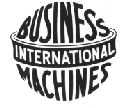|
From Abacus to Valve
The history of the calculating machines has very old origins,the first realized instrument to execute calculus dates back to 2000 B.C., it was the abacus, which was used in the old China, and then also by the Greeks and by the Romans.
The position of some little balls, which were placed in a horizontal bar, defined the numerical representation.
Napier's "virgulae numeratrices" dates a more recent epoch, it was an instrument created for the construction of the logarithm tables.
The first real machines date back to the XVII century: "machines", it means that they aren't restricted to provide a simple physical support to the operators, but they are mechanic members as a whole, which enable the automatic operations.
In 1642 Blaise Pascal, a French mathematician and philosopher, was able to execute some calculus in a very absolutely mechanic way.
So the first adding-machine, the Pascalina, was due.
A series of toothed wheels, which represent the units, the tens, the hundreds etc., carry on the crown the digits from 0 to 9, and they are connected among them through gearing.
The complete rotation of the wheel advances by one unit the wheel on its left: It was the first time that a machine executes addictions and subtractions through the automatical amount, which is also used by the modern calculating machines.
In 1671, making automatic the trigonometrical calculus, the German Gottfried Wilhelm Leibniz projected a pinion calculating machine, which executed mechanically the four operations, but it showed itself innacurate, because it was impossible to realize accurate gearing.
Leibniz was also the inventor of the binary system, which is based only on two symbols 0 and 1, so he understood that it was possible to apply it to the calculating machines.
The astronomer felt that : "if one wants to construct a more perfect machine, it is necessary to exclude the human participation to turn the wheels, or to advance the calculating machine operation by operation; instead it would be necessary to organize the things at the beginning, so the machine could do all the rest too."
Now this requirement is early compared to the calculus necessity of that epoch, infact the industrial revolution in the XIX century will give a new impulse to Leibniz's requirement.
At the beginning of the XVIII century Poleni tried it too, but his "arithmetic machine" made mistakes. The first mass-produced calculating machine was De Colmar's aritmometro of which about 1500 exsemplars were sold.
In 1804 the French Joseph Jaquard developed on an industrial scale a system to make automatic the control of the weaving loom. The loom were driven automatically in its mechanism by a series of pasteboard punch cards.
So the punch card dues, which is used to transmit to a machine the necessary operating directions.
In 1822 Charles Babbage, an English mathematician, realizes a "differential machine", which is able to execute a series of elementary mathematical operations. According to Babbage's project the machine would be moved by a steam-engine. The English mathematician set up some years later what is recognized as the forefather for excellence of the modern electronic calculating machine," the analitical engine" , which put together, for the first time, the punch card's idea with the automatical amount one.
The revolutionary aspect of the analitical machine is that was able to utilize the final issues of a calculation like starting data of the following one.
The general plan of this machine is the very same it will be adopted a century later on the modern calculating machines.
In 1880 the census of population started in America, but almost a ten-year period later it was not yet concluded. This is the reason why the worried government announced a competition to put into practice mechanically calculus.
The winner was "Herman Hollerith's Tabulator Machine" from Baltimora, who was called the first statistical engineer in the history.
Hollerith machine was the forefather of the modern calculating machines.
The census issues in 1890 were obtained in a third of time compared to ten years before, with an increased population of 25%.
It started the punch cards's epoch and with Hollerith's machine the first mechanizations on industrial scale developed in Austria, Norway, Russia and Germany.
To increase the number of the informations which are registered on every "card", Hollerith selects a dollar's dimension,which will remain the standard size of the cards.
Their capacity to contain informations is redoubled, increasing the column from 45 to 80.
At the beginning of 1900 these machines were modified, improved, made quicker using as basic element the relay.
In its more simple form the relay is composed by a wire material coil and by a metallic bar. If the coil is crossed by current it causes a magnetic field which attracts the bar causing so the mechanic members's movement which are connected to it. A hundredth second is the necessary time relay to attract the lever. The relay's opening and closing happens thanks to a device which is able to point out the perforations on the cards.
The reading cards come out of a device and then they are dragged under the reading brushes which in their turn are pressed against the drag roll.
A possible perforation on the card puts in contact its brush with the cylinder, so the electric impulse which comes from it releases the connected relay, setting in motion the connected member. The new _mechanographic machines" are able to reproduce the introduced data, to classify them, to redouble them and to divide them.
The data are also accepted and emitted by the machines not only number-shaped, but letter-shaped too, so allowing a more simple issues and treated informations' understanding.
In consequence of the achieved success, in 1924 a big company arises from the fusion of the Hollerith's Tabulating Machine Company with other little businesses which will mark the history of the calculating machines, the IBM, International Business Machines Co.
|




















